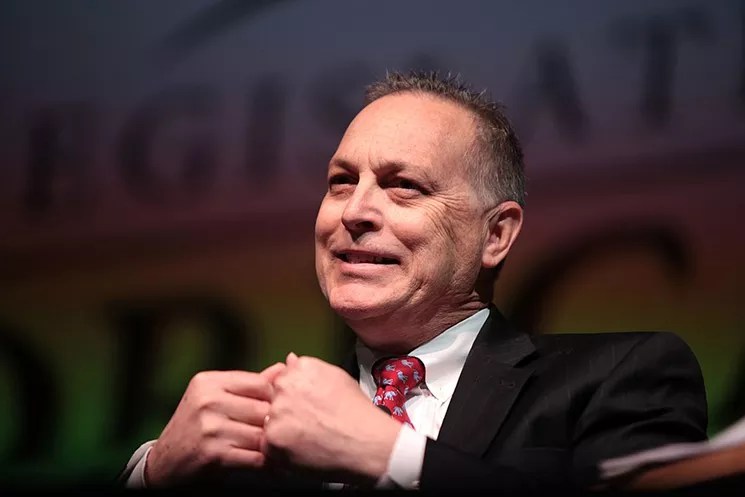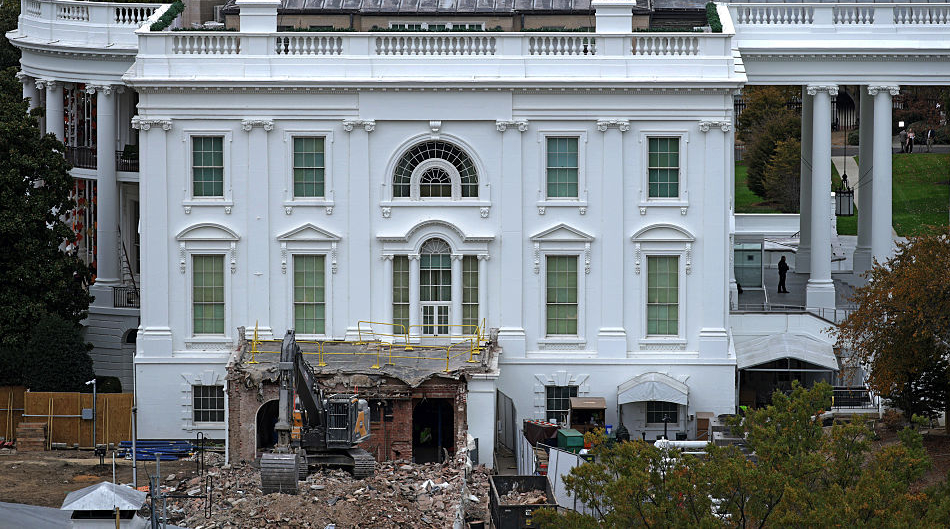
Gage Skidmore

Audio By Carbonatix
The federal government is largely shut down. As a result, roughly 40 million Americans are likely to go hungry as food assistance funding dries up, while another 24 million are at risk of losing their health care.
Meanwhile, President Donald Trump has begun demolishing historic parts of the White House to build a gaudy $300 million ballroom — paid for by donors trying to curry favor with him — which he wants to name after himself. It is perhaps the ultimate metaphor for the Trump administration’s legacy: unprecedented unilateral decisions and a historic redistribution of wealth.
Arizona Rep. Andy Biggs, a Republican from Gilbert who is running to be governor of Arizona, is one of the GOP apologists for the characteristically brash Trump remodel. Biggs was one of four GOP congressmen — all of whom are among Trump’s most loyal bootlickers — who penned an op-ed in Newsweek on Tuesday backing the president’s questionable decision to make changes to the White House without any independent assessment of the plan.
But rather than address concerns about the destruction of the historic East Wing of the White House, the shady funding for the project or the complete lack of oversight, Biggs and his fellow congressmen created a straw-man argument on behalf of their critics and hemmed and hawed about “the media.”
“The new ballroom is a practical investment in America’s most important home,” the four Republicans wrote. “For years, the White House has struggled to accommodate large-scale events, whether for state visits, national ceremonies or even bipartisan gatherings that bring leaders together. Under this presidency, the People’s House is regaining the capacity to host the American people again.”
It seems the American people, according to the congressmen, can eat cake. The op-ed sidesteps the likelihood that Trump’s ballroom at “the People’s House” will likely be used by the elite political and economic ruling classes that are cozy with the administration. After all, many of the elite are paying for it.
“After years of decline and division, America is once again leading, producing and building,” the congressmen wrote.
The opinion piece correctly notes that many presidents have made significant changes to the White House over the years. Theodore Roosevelt replaced the greenhouses in 1902, Harry Truman added a balcony and Richard Nixon put in the press briefing room. The op-ed does not mention Nixon’s creation of a one-lane bowling alley or that Barack Obama added a basketball court in 2009.
“The truth is, the White House is not a museum. It is a living, working symbol of the American presidency,” the Republicans wrote. “President Trump, a builder by nature and by trade, is doing what builders do best: improving what he’s inherited so it can better serve the nation for generations to come.”
But none of the renovations undertaken by those previous presidents approached anything near the scope of what Trump is doing to the White House, which is the largest renovation to the building in decades.
And, most notably, he’s doing it without letting anyone else weigh in.
Biggs’ chief of staff, Kate LaBorde, did not respond to a Phoenix New Times inquiry about why the massive renovation — which is much larger than the projects he cited in the op-ed — does not need a customary review of the plan.

Alex Wong/Getty Images
Acting unilaterally
The president does have the power to make changes to the White House.
The National Historic Preservation Act, passed in 1966 and signed by President Lyndon B. Johnson, requires federal agencies to review construction projects and consider impacts on historic buildings. Three buildings are exempt, however: the White House, the U.S. Capitol and the U.S. Supreme Court.
Even so, presidents have usually submitted their plans for review to the National Capital Planning Commission. An official from the Trump administration, which has not submitted a plan, said it would. But with construction already begun, that promise seems unreliable and largely moot.
Trump’s remodel is part of a larger trend. The U.S. government is shut down and Republicans, who control both chambers of Congress, are showing no signs of being able to pass a funding bill. In the meantime, Trump has been making a slew of decisions without waiting for congressional approval, including signing off on military and law enforcement pay and firing federal workers.
Several historians and critics have decried the sudden and impetuous move to tear out the East Wing of the White House.
“It was my living nightmare last week when I saw those first visual images,” Ohio University historian Katherine Jellison told Politico.
Joan Walsh wrote in The Nation: “He turned around and, with no permission or review, immediately destroyed ‘the people’s entrance’ to the people’s house. There is no better symbol of his presidency to date. The destruction would have made the late Al Qaeda leader Osama bin Laden smile; the damage to the Pentagon wrought by one of his planes on September 11, 2001, seems small by comparison.”
This isn’t the first time Biggs has covered for Trump, who endorsed both him and the slightly more moderate Karrin Taylor-Robson in the Arizona governor’s race.
Biggs was once a vocal proponent for uncovering the network of pedophiles connected to billionaire sex offender Jeffrey Epstein, crying for the release of the so-called Epstein Files for years. As recently as December, Biggs called for more information to be released about Epstein.
“Americans deserve transparency from the corrupt FBI – starting with Epstein’s client list,” Biggs tweeted in December. “Where is Epstein’s client list?” he tweeted again later that month.
But after Trump learned that he was named in the files and reneged on a campaign promise to release them, Biggs turned a 180. Earlier this year, he voted against releasing the Epstein files in an 8-2 committee vote.
Biggs has also tried to have it both ways on Trump’s deficit-nuking “One Big Beautiful Bill,” a budget measure that slashed Medicaid benefits, goosed the budget of Immigration and Customs Enforcement and funneled tax breaks to the richest Americans. The bill is projected to increase the national deficit by $3.4 trillion over 10 years, which in turn will increase the national debt.
Biggs, ostensibly a fiscal conservative and budget hawk, voted to pass it. Yet he seemed to have forgotten that last week, when he complained about the national debt getting out of control.
“Our national debt just surpassed $38 trillion,” he wrote on X. “Decades of terrible spending habits and lazy legislating from Congress are reaching a boiling point.”
As the meme goes, we’re all looking for the guy who did this.